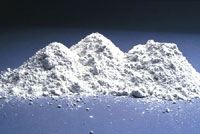
White portland cement has essentially the same properties as gray cement, except for color. It is readily available throughout North America.
The color of white cement is determined by its raw materials and the manufacturing process. Metal oxides, primarily iron and manganese, influence the whiteness and undertone of the material.
After adding pigments, white cements produce clean, bright colors, especially for light pastels. Many different colors of concrete can be created, and just like with paint, two or more pigments can be combined to achieve a wide range of colors. An even greater variety of decorative looks can be achieved by using colored aggregates and varying the surface finish treatment or texture.
Mix designs for white or colored concrete are formulated based on each ingredient's effect on concrete color:
- Type and color of cement
- Type and dosage of pigment
- Type and dosage of admixtures
- Type, gradation, color, and cleanliness of fine and coarse aggregates
- Consistent proportions, especially maintaining a uniform water-cement ratio
For every architectural project, once a mix design has been developed, sample panels should be built at the job site. These mockups serve as references for color and overall surface appearance. In North America, white cement is widely available and aggregates are abundant throughout the country. In the end, no matter where you need it, white
cement concrete can be there.
The iconic 432 Park Avenue in New York makes excellent use of white portland cement. The residential building is remarkable because of its height, nearly 1,400 feet, and small footprint, 93 feet square. Read the 432 Park Avenue case study.
Specifying White Cement
A key advantage of using white cement for decorative and architectural concrete is that it provides a neutral tinting base and consistent color results. Every color option is possible with it, from pure whites to bright and pastel colors. White cement is available everywhere in North America, though you won’t find a separate specification for it. It can be specified via a number of different standards—portland cements, masonry cements, and plaster (stucco) cements. White cement is manufactured to conform to ASTM C 150, Specification for Portland Cement. Types I and III are the most common, but Types II and V are also produced.
Concrete and All Other (General) Uses
ASTM C 150 for portland cement is the most common cement spec in North America. Of the five basic types of cement covered under this spec, Types I through V, Types I and III white cement are the most prevalent, but Types II and V are also manufactured. Manufacturers usually control color of white cement by limiting the amount of iron and manganese oxides allowed. why is it used in decorative concrete.
ASTM C 595 on blended cement includes other pozzolanic or slag materials in the cement. There is no inherent reason why white cement could not be produced under C 595. However, byproduct ingredients like pozzolans or slags may not be color controlled to the same degree as portland cements, so a blended cement product is more likely to vary in color. Therefore, white cement would probably not be specified under this standard.
ASTM C 1157 on hydraulic cement is based on performance characteristics. The six types of cement described by this standard are closely correlated to the types of cement in C 150. In fact, cements that meet C 150 often simultaneously meet C 1157. The most common, Type GU for general use, is similar to a Type I. Type HE, high early strength, is similar to a Type III. These would be the most likely C 1157 materials to be requested for white and colored concrete uses, much like Type I and III are the most popular C 150 types for those purposes.
CSA A 3001 is the Canadian Standards Association standard for Cementitious Materials for Use in Concrete. The portland cement nomenclature is the same as C 1157. The blended cement nomenclature builds off those designations. As with the ASTM specifications, white cement could be specified under the portland cement designation, but would not likely be specified under the blended cement specifications. See CSA Group for more information.
Masonry Mortar and Stucco
Other cement specifications have been developed specifically for special construction uses.
ASTM C 91 on masonry cement is used to make both mortar and plaster (stucco). C 91 has Types N, S, and M. Many cement companies ship these materials in bagged, colored mixes to save the end user the time and trouble of blending materials on the job.
C 1328 on plastic or stucco cement is used for stucco applications but this material is found primarily in the southwest and western portions of the United States. C 1328 has Types S and M. As with C 91, these materials can be premixed with color pigments to simplify job site use.
Incidentally, C 150 is also used for mortar and stucco, but it is mixed with lime to provide workability. These mixes can be white or colored and can be premixed, too.
ASTM C 1329 on mortar cement is a sister product to C 91. The difference is that mortars made with mortar cements must have certain minimum bond strengths because these materials are intended for use in more structurally demanding applications. Cement types are the same as in C 91: N, S, and M. While it is not disallowed, there does not seem to be much demand in the marketplace for white mortar cement.
CSA A 3002 is the Canadian Standards Association standard for Masonry and Mortar Cement. Similar to ASTM C 91 and C 1329, this single standard covers both materials in the same specification. Like ASTM, masonry cements could be specified as white, but mortar cements would likely not be. One notable difference from the ASTM counterparts is that A 3002 only recognizes Types N and Type M is not included.